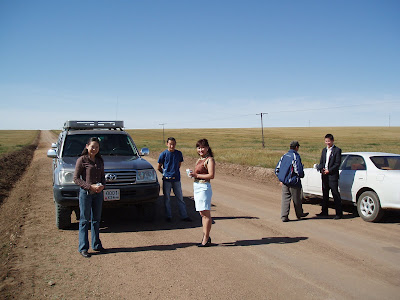On the saturday we travelled onto Dalanzadgad, our visit coincided with the annual market day and Gobi Festival organised by Mercy Corps.
The race was great: 5 entered the full marathon, 15 the half. Some had travelled from Germany, France and Macau just to enter the race; others were westerners living in Ulaanbaatar and there was one mongolian entrant, a tour guide with one of tour companies. The course was across desert tracks, mainly stones on a sandy base, then at 10 kilometres there was a 2.5 km climb up a sand dune, and at 19 kilometres a 1.5 kilometres ascent to the top of the Flamimg Cliffs, where the first dinosaur eggs were discovered in the 1920. The red sandstone cliffs the backdrop to an amazing finishing line.

team vso
Team VSO managed a respectable 3rd, 4th and 5th place.














